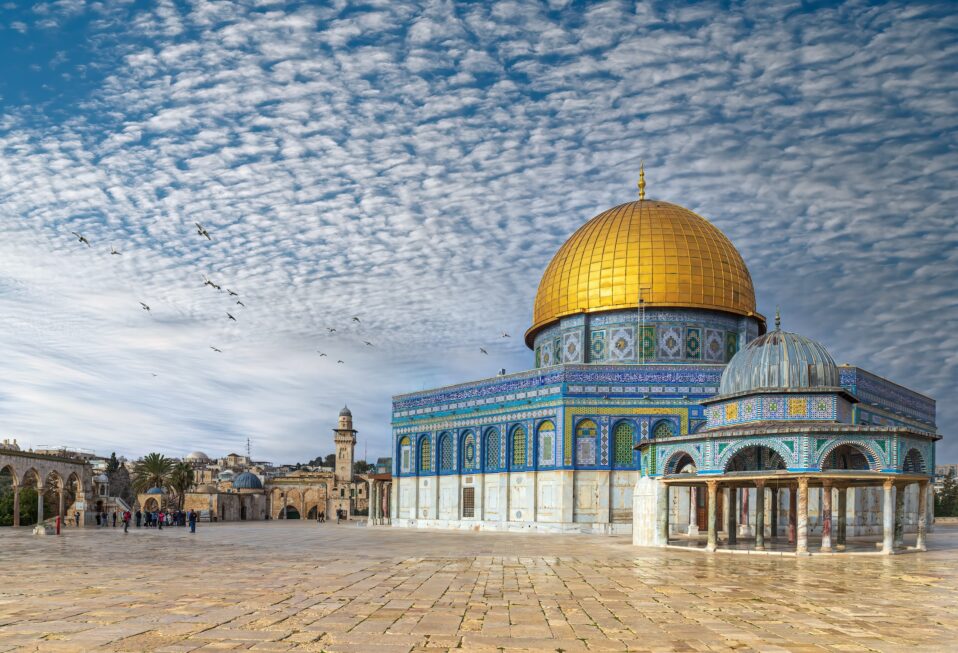By Stephen Faircloth
Rising above Jerusalem, the Temple Mount has long stood as a symbol of faith, devotion, and divine presence. Today, the golden Dome of the Rock gleams from its ancient platform, but beneath it lies a history stretching back over three thousand years to the time of King David.
Around 1000 B.C., David captured the Jebusite city of Jerusalem and made it the capital of his kingdom. On the eastern hill, he built his palace and brought the Ark of the Covenant to rest in a tent. His son Solomon later expanded the city to the north, building the royal palace and the First Temple—the dwelling place of the God of Israel. For nearly four centuries, it stood as the spiritual center of the nation until it was destroyed by the Babylonians in 586 B.C.
When the exiles returned from Babylon, they rebuilt the Temple under Zerubbabel, creating what became known as the Second Temple. Centuries later, Herod the Great began an enormous renovation project that transformed the modest structure into one of the most magnificent sanctuaries in the ancient world. He built massive retaining walls that expanded the summit of Mount Zion into a vast platform, making it the largest sacred space in the Roman Empire.
Herod’s Temple was the one known to Jesus, Mary, and the apostles. Inside its courts stood the Holy Place, where the golden lampstand and the Table of the Bread of the Presence were kept, and beyond it, the Holy of Holies, entered only once a year by the high priest on the Day of Atonement. Pilgrims from across the ancient world ascended its steps to offer sacrifices and prayers, believing this was the place where heaven and earth met.
In A.D. 70, the Romans destroyed Jerusalem and Herod’s Temple, leaving only portions of the retaining walls that supported the Temple Mount. Over the centuries, new structures rose upon the site—pagan shrines, Byzantine churches, and later, the Islamic monuments that remain today: the Dome of the Rock and the Al-Aqsa Mosque. Through all these changes, the Temple Mount has remained a place of reverence, prayer, and longing for generations of believers.
For Christians, the Temple Mount reminds us of Jesus’ words: “Destroy this temple, and I will raise it again in three days” (John 2:19). He was prophetically speaking of His body, revealing that God’s presence would no longer dwell in stone buildings but within the hearts of His people. Through Christ, every believer becomes a living temple, carrying the presence and Spirit of God into the world.
The Temple Mount, with all its layers of history, invites us to consider what kind of temple we are building. Is our faith built upon outward ritual, or upon the indwelling presence of God? The same God who once filled Solomon’s Temple with His glory now calls us to be living temples of His Spirit, reflecting His light in a dark world.
The Temple Mount stands as a reminder that while sacred spaces can be destroyed, the true dwelling of God endures in His people worldwide. How are you making space for His presence in your life today?
Stephen Faircloth is the President of CBN Israel, an initiative dedicated to sharing the true story of the Jewish nation and inspiring a global community of Christians to stand with Israel and support her people in need. Our vision is to reshape the global conversation about Israel by fostering understanding, hope, and healing between Jews and Christians around the world. For more than 50 years, the Christian Broadcasting Network has supported Israel. By joining CBN Israel, you become part of this enduring legacy, transforming lives today and strengthening Christian support for Israel for generations to come.




Post a comment